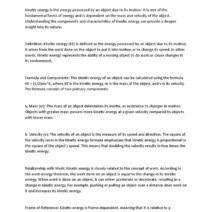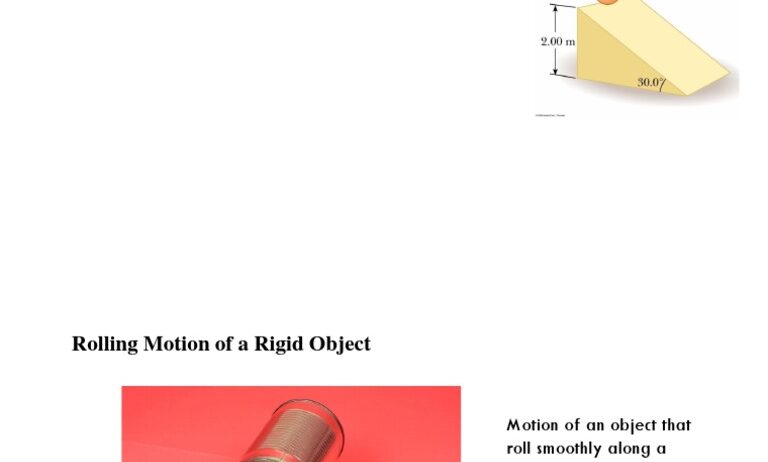Understanding the fundamental principles of energy conservation provides a basis for many scientific and engineering disciplines. Among various forms of energy, rotational kinetic energy occupies a unique position, influencing not only physics but also engineering and environmental systems. This discourse intends to elucidate the concept of rotational kinetic energy and explore whether it is conserved in certain scenarios.
To unfold this theme, we embark on a systematic examination of rotational motion, dissect the conditions under which rotational kinetic energy conservation occurs, and investigate practical implications in real-world applications.
Defining Rotational Kinetic Energy
Before delving into conservation principles, it is essential to understand what rotational kinetic energy entails. Rotational kinetic energy refers to the energy possessed by an object due to its rotation. This energy is quantitatively expressed through the equation:
KE_rot = 1/2 * I * ω²
In this equation, KE_rot is the rotational kinetic energy, I represents the moment of inertia, and ω is the angular velocity. The moment of inertia is a measure of how mass is distributed relative to the axis of rotation, leading to varying energy storage in rotating bodies. The greater the moment of inertia and the angular velocity, the higher the energy stored as rotational kinetic energy. Hence, a powerful understanding of these variables is crucial for analyzing systems involving rotation.
Mechanisms of Energy Transformation
Rotational motion does not exist in a vacuum; it interacts dynamically with translational motion, potential energy, and various forms of work. Energy can transform from one form to another within a system. For instance, imagine a pendulum. As it swings, energy shifts from gravitational potential energy to rotational kinetic energy and vice versa. Such transformations underpin the conservation laws found in physics.
To ascertain whether rotational kinetic energy is conserved, one must examine specific scenarios. In an ideal system, where no external torques or forces act, it would seem that rotational kinetic energy remains unchanged. This leads to the concept of energy conservation within closed systems. However, real-world conditions often introduce complexities, necessitating a deeper analysis.
Conditions for Conservation
In the realm of dynamics, conservation of rotational kinetic energy occurs primarily in elastic collisions or systems without net external torque. In these instances, the initial and final states of the rotating body maintain energy equilibrium. For instance, consider two rigid bodies colliding elastically. They exchange linear and rotational kinetic energy without external influences, leading to a conservation of total kinetic energy throughout the collision. Each participant in the interaction conserves its own rotational kinetic energy, demonstrating how energetic exchanges can occur yet maintain total energy balance.
However, when external torques or non-conservative forces, such as friction or air resistance, are at play, the simple conservation of rotational kinetic energy breaks down. Energy dissipation occurs, generally in the form of thermal energy which introduces a fascinating dimension to the discussion. In these observational scenarios, the rotational kinetic energy lost to frictional forces converts into heat, which is then dispersed into the environment, underscoring the importance of external interactions in energy systems.
Real-World Applications of Rotational Kinetic Energy
Understanding rotational kinetic energy conservation carries significant implications for various industries, particularly in mechanical and aeronautical engineering. Engineers frequently design systems, such as flywheels, which harness this energy. A flywheel operates on the principles of angular momentum and energy conservation, storing energy efficiently for later use. Its ability to conserve rotational kinetic energy allows it to stabilize energy supply in power systems.
In automotive engineering, rotational kinetic energy plays an equally pivotal role. Here, the study of energy transfer helps optimize fuel efficiency. For example, regenerative braking systems capture the energy typically lost during braking, converting it back into useable energy to recharge vehicle batteries. These systems highlight the practical application of conserving energy through innovative mechanisms.
Environmental Implications
Exploring rotational kinetic energy also prompts a necessary dialogue regarding sustainability. By understanding the principles of energy conservation, industries can develop technology that minimizes energy waste. Efficient energy systems can reduce fossil fuel dependency, promoting a greener, more sustainable approach to energy consumption and production. As societal pressures mount to confront climate change, innovations centered around energy conservation will undoubtedly become increasingly valuable.
In summation, while rotational kinetic energy is indeed subject to conservation under specified conditions, various factors can lead to its transformation into other energy forms. This exploration serves not only as an analysis of physical principles but also as a call to action for industries and individuals alike to embrace energy-efficient practices. Understanding the nuances of energy conservation empowers a sustainable future grounded in scientific principles.








